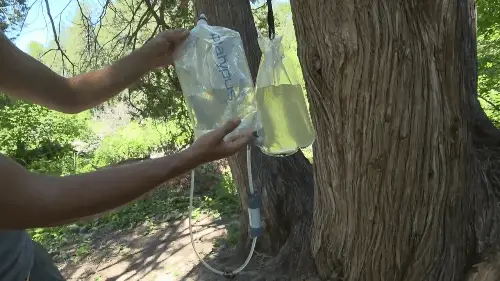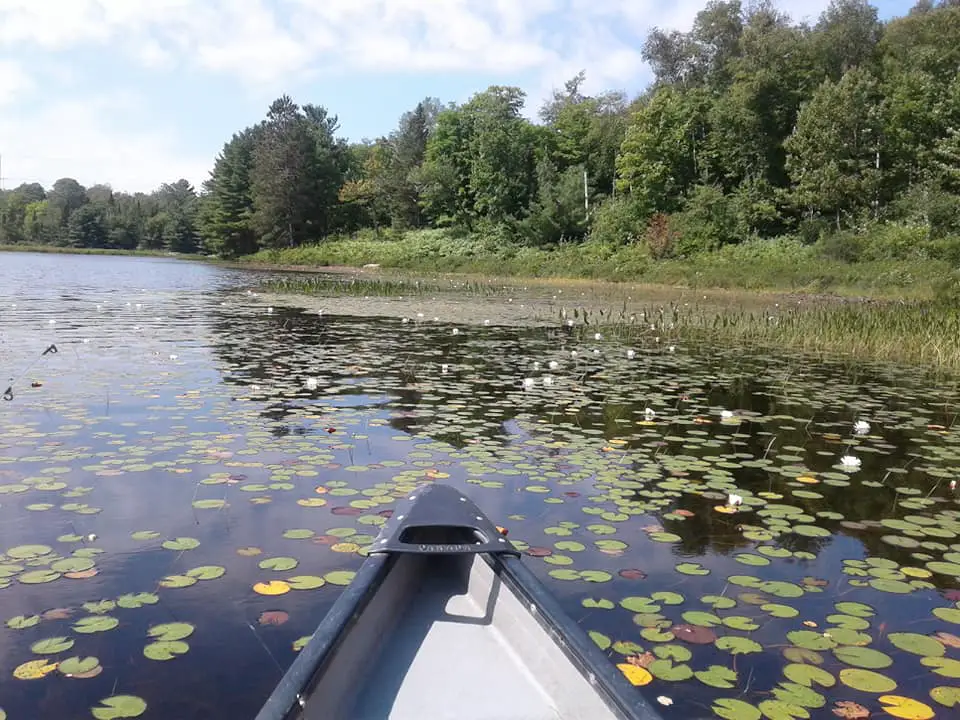If you love staying out in the bush for extended periods of time chances are you will find yourself running low on the water you brought with you. This is where wilderness water purification comes in very handy, it could potentially even be life-saving if you find yourself in a survival situation.
There are 7 key ways to filter or collect water when out in the wilderness; Boiling water, using a coffee filter, straw filters, water purification tablets, tree barks, solar stills, portable water filtration systems.
All of the 7 key ways to filter/collect clean drinking water are very easy to achieve, some may take more time than others and some may be more effective than others. Let’s get into more detail.
How to properly Filter Water In The Wilderness
From rain and dew to groundwater and ponds, there are infinite sources of water in the wild. However, it is full of microorganisms like bacteria and several other contaminants. So, what is the solution to getting fresh water in a forest? You will be amazed at how many ways you can filter water when practicing bushcraft.
1. Boiling Water
The easiest way of filtering water is by boiling it. Be it full of dirt, animal feces, debris, or other contaminants, boiling can kill most of the germs from the water. Thus, you can get pure water to drink without any worry of falling ill.
That said, you must first separate the dirt, debris, or other particles from the water before boiling. If you boil the water and some poisonous leaves or other contaminants, they may get mixed in the water. as a result, even the boiled water will be highly unfit for drinking.
One effortless way of making water free of leaves, dirt, and other solid debris is filtering it through a cloth piece. You can use your cotton shirt as a filter to remove the solid impurities and boil the clear water.
Remember, clear water may also have several contaminants, which is why you must allow the water to bubble for 5 minutes. Once it is boiled, you must leave it for a few minutes to let any remaining impurities settle down.
The entire process will take 10-15 minutes, and you will have entirely germ-free drinking water!
2. Coffee Filter
Did you know that coffee filters can filter water? You do not need to carry your entire coffee machine, just a small and ultra-light filter piece. It is usually a piece of paper that intends to trap coffee ground while only the liquid flows through.
You can use a coffee filter to get rid of debris and other big-size impurities from water. For this, you must set the filter on a funnel-like object and place it on top of a bottle. As you pour water, the filter will trap dirt, soil particles, leaves, and other visible contaminants.
You must note that a coffee filter cannot remove or kill any microorganism or other harmful things. Therefore, you still need to boil the water after this process to make it healthy enough for drinking.
3. Straw Filter
A straw filter is one of the handiest tools when it comes to filtering water on the go. It is a small device that allows you to drink water directly from ponds, streams, and other water sources. All that without the harmful contaminants entering into your mouth. How?
It is a small (10-11 inches) tool that contains a high-level filter. Its 0.2 Micron Hollow Fiber Membrane traps 99.99% of waterborne bacteria, protozoan, microplastics, and multiple other microorganisms. Thus, you get clean drinking water.
To use a straw filter, you need to suck water from the mouthpiece. It can be done from any water body, bottle, or other water sources. Once you have finished drinking, you must blow into the mouthpiece to throw out the remaining dirty water.
One of the best things about a straw filter is that it is available at a relatively affordable price. Additionally, most of these devices come with a prolonged life span of 1-5 years!
4. Survival Water Purification Tablets
Before setting on an adventure, you must be all geared-up. You never know what situation you may come across, which is why you need to be prepared for the worst. A water purification tablet must be one of the essential bushcraft items on the list of emergency supplies in your bag.
These tablets are usually made of germ-killing elements that are also useful for your body (small amounts only). It includes potassium permanganate, chlorine, and iodine, which have proven effective in killing harmful microorganisms.
To use these tablets, fill a container with water, add the required amount, and shake it well. It will ensure that the contents of the tablet perfectly blend with the water. Also, it would be best if you let the water be still for 15-20 minutes to allow any undissolved particles to settle down.
Despite the beneficial technique, it has a drawback. You need to measure the water to use a precise amount or number of tablets for filtration. In most cases, you will need almost 20 liters of water for one water purification tablet.
5. Tree Barks
Believe it or not, you can get clean water from trees that may not even require filtration. Several trees such as Maple, Elm, Birch, Hickory, Walnut, Palm, Poplar, Box Elder, and others can be used to extract water. Plus, it is a relatively simple process.
You just need to make a cut of about one inch in the bark, and water will slowly start dripping. Place a leaf or twig in the opening to direct the flow of water into the container. However, there are some conditions for the same.
You cannot use this water if it is thick or has a dense color. That is mostly seen in evergreen trees, which is why you must avoid them. Other than this, the tree water is safe for drinking. Moreover, in most of the trees, the water will contain multiple minerals and sugar that are beneficial for your body.
Extracting clean water from tree barks primarily works for bamboo trees and vines. They mostly store a considerable amount of water that is fit for drinking directly. Yet again, if you find the liquid to be extra-thick or milky, do not drink it.
6. Solar Still
If you find a contaminated water source and do not have the means for boiling, create a solar still. It is an excellent option for distilling water or obtaining clean water from the surroundings. However, it requires a bit of an effort for the setup.
Here’s how you can build a solar still:
Step 1: Dig a hole in the ground that is almost one foot deep. Make sure it is wide enough for the best results.
Step 2: At the center of the hole, place a container that will store the water.
Step 3: Cover the hole with a clean sheet (preferably plastic) and pin it from the edges. You may use rocks, soil, or other heavy things to keep it in place, but do not make it tight.
Step 4: Place a light stone in the middle of the sheet, with the utmost care without disturbing the setup. You need to ensure that you place the rock directly above the container.
Voila! Your Solar Still is ready, but how does it work? As time passes, the contaminated water will evaporate and condense on the sheet. Next, the mist on the sheet will be directed towards the center and fall into the water container. The water will be entirely safe for drinking.
Though it is a time-taking process, Solar Still proves to be useful for filtering water in the wild. More so in regions with high-fluctuating temperatures.
7. Portable Water Filtration System
Most ways of filtering water take some time and require some sort of set up. However, a portable water filtration system can save you from all the hassle of purifying water. It is lightweight, fits in your backpack quite quickly, and is indeed the best bushcraft water filter method.
One such superbly-useful tool is the Platypus GravityWorks 2.0 Liter Complete Water Filter Kit. Read on to know more about how you can seamlessly filter water even in the wild.
Platypus GravityWorks 2.0 Liter Complete Water Filter Kit for Camping and Backpacking

If you are one to spend a lot of time outdoors and deep in the bush the Platypus GravityWorks water filter kit is perfect for you. It can give you 1.5 liters of perfectly-clean water within a minute, isn’t that incredible?
The kit includes two 2 liter bags, for dirty and clean water. To use this system, you need to fill a bag with contaminated water. It may be from a stream, pond, or any other source. Hang the filled bag on a branch or any other object.
It contains a hollow fiber filter that traps 99.9999% of bacteria and 99.9% of protozoa. So you can rest assured that your drinking water is safe for consumption after use. The filtered water will transfer and get stored in the clean water bag. You can quickly fill your containers from this. Additionally, you can also control the water flow in the hose with the clamp that comes with the kit.
Need more? The Platypus GravityWorks water filter kit is ultra-light, weighing only around 10.9 ounces. So, you can carry it around without added weight on your shoulders. Also, it has a capacity of filtering 1500 gallons of water. You can use one cartridge for a considerably-long time!
Water Contaminants in Natural Water
Despite your immense love for being in the bush and practicing the multiple survival techniques you have learned, always remember that health comes first. Drinking contaminated water can be fatal. Here is a list of the harmful contaminants that you may not see but are present in natural water sources.
Viruses
One of the smallest types of contaminants are viruses. They are fragile and can transfer from one source to another super-fast. Needless to say, if they get into your body, they can cause severe illness or even death. Some examples of viruses may be polio, norovirus, hepatitis A, etc.
Particulates
It is the group of relatively more significant contaminants, such as twigs, dead insects, twigs, etc. Though they may not be too harmful, particulates make way for other pollutants. Therefore, you must remove these before applying your primary filtration method.
Bacteria
It is a contaminant that is present in most water sources. Bacteria usually come from animals or human feces, urine, etc. It is a microorganism that can cause sickness, diarrhea, and severe disease such as Leptospirosis.
Parasites
It is one of the most notorious groups of water contaminants. Parasites may range from tapeworms and flukes to Giardia and more. While some of these may cause mild sickness, others such as Giardia can lead to severe illnesses, even death.
Chemicals
These are the smallest types of contaminants and also the most difficult to treat. Chemicals make their way into water sources through industrial waste and other such toxic material.
Final thoughts
If trekking, camping, and practicing bushcraft are your hobbies, always make sure to carry a sound water filtration system. You can find water from a plethora of sources, even at the center of a dense forest. Still, you can never be sure of its purity.
So, equip yourself with the right bushcraft water filter ideas and gear to stay healthy and enjoy to the fullest!
Was this post helpful?

Hey I’m Josh! I have been practicing Bushcraft for a little over 6 years now! I Started this website to review awesome bushcraft gear that I love as well as share information I have learned along the way!


